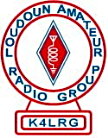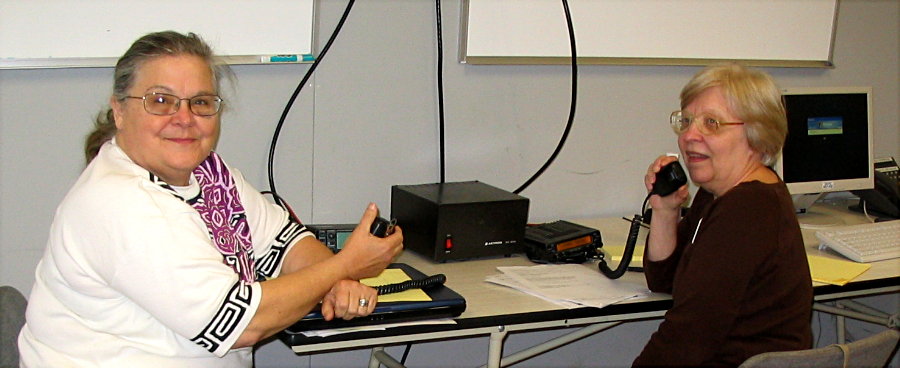The Virginia Department of Emergency Management described VERTEX 07: "Virginia Emergency Response Team Exercise 2007 involved response personnel from state and local government and volunteer groups in reviewing and practicing the skills needed during an actual emergency in a three-day statewide exercise on April 24-26, 2007. Though the Virginia General Assembly mandates VERTEX to occur annually, this is the first time the exercise exceeded one day.
Response agencies and local government representatives role-played their emergency operations functions from the state and local government emergency operations centers. The Virginia Emergency Operations Center was fully staffed to simulate the Commonwealth’s response to a major hurricane. The exercise was intended to test our readiness for dealing with a Cat 3 hurricane making landfall in the Virginia coast.
Region III jurisdictions conducted a tabletop exercise in conjunction with VERTEX, and northern Virginia localities and federal partners conducted the Regional Response exercise in support of VERTEX on April 26. The Fusion Center is participating in Noble Resolve, a concurrent exercise run by the U.S. Northern Command April 23-25."
On May 5, 2007, Virginia ARES posted the following on their Internet Site: "The Virginia Department of Emergency Management (VDEM) held a major exercise called VERTEX 2007 from April 23 through April 26, 2007. The exercise was intended to test our readiness for dealing with a Cat 3 hurricane making landfall in the VA coast. The ham station at the VA Emergency Operation Center (VAEOC) was active as W4ZA during this exercise."
Terry Hebert, KG4GLS, VDEM / VEOC Operations Watch Officer has passed along the following:
| |
"I wanted to thank all of those you participated in this years VERTEX Exercise. From the results achieved by our Amateur Groups both in the VEOC and in the field it was a success. I have attached my After Action Review (AAR) that was submitted to the planning group with some areas that need to be improved."
|
|
Several Virginia ARES after action reports on VERTEX 2007 have been posted to the Virginia ARES Internet Site; click here. There are some interesting numbers about state wide nets and traffic. And a few observations.
The Loudoun County ARES Volunteer Approach
Those active in Loudoun ARES try to practice what we are asked to do. Most look to our Emergency Coordinator's September 6, 2006 advisory about emergency amateur radio operations. Tom Dawson's words are still quite operative:
| |
The emphasis on emergency communications in the Amateur Radio community has come to the forefront since 9-11. A significant part of this is learning to function with others during emergencies. The ARRL has developed a number of fine courses relating to Amateur Emergency Communications.
As the ARES Emergency coordinator for Loudoun County, I encourage individual ARES members to gain training and experience in emergency communications and general traffic handling. I do not, however, require formal training. Individuals who may have been unable to schedule themselves in the ARRL classes should not feel constrained when it comes to volunteering for emergency or public service events. There is no substitute for experience in any aspect of Amateur Radio, nor in any aspect of Emergency Response. All ARES members, and for that matter, all Amateur Radio operators should avail themselves of every opportunity they can to participate in the many field activities of LARG, Loudoun ARES, RACES and the Traffic Nets.
Remember, the first step to making useful contributions to Amateur Radio Emergency operations is to just be a good Ham. This means being familiar with you own equipment, and the general Amateur Nets and other activities in your area.
While classroom/online training will help you familiarize yourselves with many aspects of emergency management, the National Traffic System, and some of the other networks employed around the country, our local experience has shown that the following are the most important capabilities volunteers should have to be useful to the served agencies:
1) The ability to function within a Directed HF/VHF/UHF Voice Net.
2) The ability to pass formal traffic using the ARRL Format.
3) The ability to set up a VHF/UHF voice station capable of 25 + Watts of output power using battery or generator power-anywhere.
4) The ability to set up an HF voice station capable of 100 + Watts of output power using battery or generator power-anywhere.
5) The ability and willingness to remain on station for 12 + hours.
Obviously, not everyone will meet all five of these criteria, but being able to meet any one of them qualifies you for participation emergency and public service events. Active participation in the National Traffic System Nets, the easiest one being the Northern Virginia Traffic Net that meets on 147.30 nightly at 7:30 PM local time, and the ODEN net that is regularly announced on these reflectors, as well as participating in First Night Leesburg, the LARG Balloon Launches, ARRL Field Day, and the Reston Bike Club/Red Cross Bike ride in Loudoun every August are key activities that will prepare you for actual emergencies far more than any class ever could. After all. would you want to ride in a plane where the pilot had only classroom training?
So please, sign up for the various Ham Radio activities, including classroom training, as much as you can. Support the Traffic Nets and public service nets, handle some message traffic and put together the batteries, cables, and antennas (your go-kit) you'll need to get a relocation center, or other site on the air in a reliable and efficient manner.
When your schedule allows, sign up for the League online courses, or other FEMA or County EMS courses that may be available from time to time.
Scheduled ARES/LARG/Other public service events known so far this year are as follows:
17 September: Clarke County Bike Ride: contact Mark, K4GYT ([email protected])
30 September: Oktoberfest in Lovettsville : John Westerman Coordinator
14 October Ashburn Emergency Preparedness Fair at Ashburn LDS Church
More information on these activities will follow.
For other ARES information contact myself as listed below or subscribe to [email protected]
Also, listen to the 147.30 WA4TSC Repeater, 145.31 N4FSC, and 147.48 Simplex during possible emergencies. Emergency nets will be announced on these frequencies.
Best Regards, Tom Dawson - WB3AKD
ARES EC Loudoun County, VA
(540) 454-0520 (Cell)
(877) 790-3115 (Pager)
[email protected]
NNNN
|
|
Exercise Preparation in Loudoun
Here in Loudoun County, the ARES participation in VERTEX 2007 was directed by our ARES Emergency Coordinator, Tom Dawson - WB3AKD of Round Hill. In the spirit of a semi-no-notice exercise, there was only a brief mention of the exercise requirements at our Loudoun Amateur Radio Group monthly meeting on April 21, 2007. Tom asked several who had deployed in VERTEX 2006 to assist again. Later on April 22, 2007, Tom Dawson issued via email the following Operations Plan to those who stepped forward:
| |
LOUDOUN AMATEUR RADIO OPERATIONS PLAN
VERTEX 07 (Hurricane Drill)
26 APRIL 2007
Situation:
The Loudoun Emergency Management Services (EMS) has tasked LARG / ARES to support their participation in the annual VERTEX exercise at the EOC on 26 APR 07. The Loudoun ARES/Loudoun Amateur Radio Group (LARG) will participate by staffing the Loudoun Emergency operations Center (EOC) Ham Radio Position and coordinating with local home stations to maintain a link to the State EOC in Richmond, EOC's in Fairfax and Prince William as well as other sites around the Leesburg area.
Mission:
Amateur Radio Operators will Provide Communications support between the Loudoun EOC, potentially other sites in the Leesburg area, Fairfax and Prince William EOC’s and the State EOC in Richmond. Voice, Packet and WiFi are expected to be required.
Execution:
1) Approximately 0730, Tom, WB3AKD, and a technical team will deploy a Portable Tower near the EOC on Courage Ct. This tower will support the EOC HF Antenna and WiFi Node, while portable masts will support the VHF/UHF Voice and Packet Antennas.
2) Approximately, 0815, EOC Radio Operators will arrive and check in at the EOC and radio check Norm, AI2C on voice and packet.
3) At 0830 EOC Operators will attend the STARTEX Briefing
4) At approximately 0900 Loudoun ARES EC will send an Amateur Radio status message via HF/Packet to the State EOC.
5) Voice and text traffic will be handled as required.
6) In the event of an internet failure, ARES will attempt to deploy WiFi system to reestablish connectivity.
Service and Support:
Lunch may be available at the EOC; however, participating LARG/ARES members should insure that they have extra batteries, water/fluids and snacks and for this event. The EOC will be heavily staffed and drink machines will see heavy use. Self sufficiency, as always, is the best policy.
Command and Communications:
Loudoun Emergency Management Leads the Exercise
EOC Call is K4LRG. (Tactical Loudoun EOC)
Amateur Radio Lead at EOC is tom WB3AKD
Offsite Lead and Local Net Control is Norm AI2C.
Primary Net frequency will be 443.225 MHz Simplex.
Talk-in and Technical Ops will be 147.48 MHz Simplex.
HF Frequencies are 3947 KHz +/- and 7243 +/-, Both LSB
Packet Frequency is TBD.
Lost Comms is 147.48 Simplex.
Emergencies will be passed directly to 911 via cell phone, if available, otherwise to Loudoun EOC. Note location and nature of the emergency before calling it in. When making an emergency call, so specify in your first transmission i. e. “This is K4XYZ, EMERGENCY, OVER”. If an Emergency call is sent the net will automatically become a directed net. Stations not involved in the emergency will stand by until Net Control terminates the emergency.
NNNN
|
|
Pre-Exercise Checks At AI2C de Canby
The day before the exercise, Norm Styer - AI2C on Canby Road at Clarkes Gap checked his equipment, reviewed the Loudoun ARES operations plan, and the Virginia VDEM and Virginia ARES Internet Sites. The Virginia EOC was operational on 3947.0 kHz as part of the VERTEX and communications checks were conducted with W4ZA in Richmond at the Virginia EOC. A second check of the state-wide packet radio system was conducted with a message sent to W4ZA@W4ZA. On the afternoon of April 25, Norm Styer sent the following report on preparation and readiness to Tom Dawson and others preparing to participate:
| |
DATE-TIME: Wednesday, April 25, 2007 1:23 PM
SUBJEST: VERTEX 07 SITREP at AI2C
Hello All,
Just a quick status report de AI2C. I visited the VA ARES Internet Site and discovered that VERTEX07 is on-going.
Made following comm checks today, Wednesday, 25 April 2007:
1510Z checked into 3947.0 kHz VERTEX Net with NCS: W4ZA at VAEOC - Good and readable.
1545Z logged onto N4NSP - Linden 145.73 MHz Packet Station as AI2C-4 and send "Comm Check Message to W4ZA @ W4ZA" Received reply about 1 hour later. See Attached Dump of Packet files.
1640Z Closed station on 3947 kHz.
Status for tomorrow at AI2C:
HF 3947 kHz SSB PHONE with switchable capability to 7240 kHz.
VHF FM PHONE 147.480 MHz SIMPLEX at 10W to 11-element yagi at 25 feet
VHF Packet 145.730 MHz at 35W to 5-element yagi at 45 feet - using AI2C-4
UHF FM PHONE 443.225 MHz SIMPLEX at 25W to 5-element yagi at 45 feet
INTERNET - eMail via [email protected] but will not disable security here to enter Loudoun EOC System
Telephones: LANDLINE: 540-338-2584 and CELL: 571-201-6322
See You In The Pile-Ups. Best Regards,
Norm Styer - AI2C de Canby - Clarkes Gap - Loudoun County - Virginia
May The Morse Come To You !!!
NNNN
|
|
Operations At Loudoun EOC
By 0700 hours, as I came up on 147.48 MHz simplex, Tom Dawson - WB3AKD was mobile in western Loudoun County and looking for a tail guard for his over loaded tower trailer. He asked for John Unger - W4AU and we got him turned around at Clarkes Gap. At about 0725 hours, AI2C passed one early message from W4ZA-Virginia EOC to WB3AKD that had been distributed on packet system several hours before the start of the local exercise. Within the hour, all had arrived at the Loudoun EOC and work on assembling antenna started. At about 0845 hours, K4LRG was on the air from within the EOC.
 The Antenna Erection Crew
The Antenna Erection Crew
John Ives - KI4TXP of Leesburg, Grant Russell - KI3EMT of Round Hill, Tom Dawson - WB3AKD of Round Hill,
John Unger - W4AU of Hamilton and Victor Carter - KB9WXV of Ashburn
After the basic communications were operational from the EOC on the VHF and UHF frequencies, Tom and his crew set to work on bringing up a WiFi system and later an HF link. The WiFi network operated in the 2.4 Ghz band and was intended to restore, if necessary, basic communications between the county EOC and the town of Leesburg's EOC. The approach was to distribute WiFi repeater packages along the route. Three remote repeaters had been completed when the exercise was terminated.
Communications operations by the ARES stations at the EOC was minimal. A couple messages were processed. These were ARES related subjects regarding ARES manning levels and needs. They were relayed through the off-site station at AI2C. No other traffic was passed. The exercise terminated about 1300 hours.
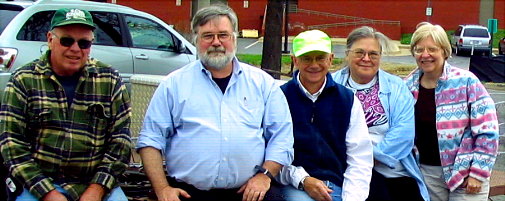
John Ives - KI4TXP of Leesburg, Tom Dawson - WB3AKD of Round Hill,
John Unger - W4AU of Hamilton,
Margaret Gentges - AI4UX of Great Falls and Carol Boehler - KF4TJJ of Leesburg
|
Portable Antennas At Loudoun EOC
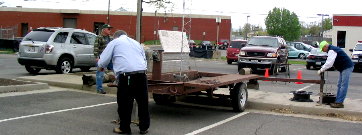
Portable Antenna Platform
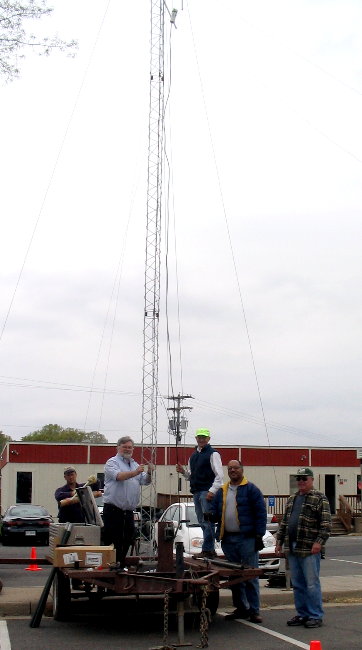
The Portable Antenna Systems
By Tom Dawson - WB3AKD
|
Operations At Ai2C
The operation from AI2C on Canby Road was responsible for prime or alternate routes by several communications means between the Loudoun EOC and the Virginia EOC and for NCS, as required, or for ANCS of local Loudoun nets.
The exercise at AI2C went off better than the first one in 2006. First, we knew more about the situation, the capabilities of all concerned and what was expected of us. AI2C had good communications with the mobiles enroute, man-portables at and semi-fixed ARES stations at the Loudoun EOC on VHF and UHF nets and made a good and readable check with WB3AKD at the EOC on 3947 kHz later in the exercise. The two links to the Virginia EOC worked but more would have been needed if there was going to be any substantial traffic handled. W4ZA in the Virginia EOC was good and readable throughout the day. The VHF N4NSP packet node are always available. AI2C just dumped the traffic on to it that was addressed to W4ZA@W4ZA. Later, an outstation on HF assisted AI2C in establishing a 'direct' path to the W4ZA Bulletin Board on which W4ZA at the Virginia EOC was connected.
At the end of the exercise, Norm Styer - AI2C filed the following after action report with Tom Dawson - WB3AKD, EC Loudoun ARES:
| |
SUBJEST: The Operating Log of AI2C during VERTEX-2007
DATED: 2000 hrs, Sunday, April 29, 2007
OPERATIONAL PERIOD #1. At mid-day on Wednesday, April 25, 2007, AI2C conducted communications checks on 3947.0 kHz on PHONE with W4ZA in the VA EOC and via packet radio via N4NSP on 145.730 MHz with the VA EOC. The following two messages were exchanged on packet radio.
VERTEX – 07 MESSAGE # 1 de AI2C to W4ZA @ W4ZA at VDEM
NR 1 R AI2C-4 Loudoun County VA 1520Z 25 APR 2007
TO W4ZA @ W4ZA
BT
VERTEX DRILL COMM CHECK VIA PACKET
CONNECTED TO N4NSP LINDEN
REQUEST CFM RECEIPT VIA PACKET
END OF DRILL
SGN NORM CHOP AI2C
BT
*** END OF MSG # 7328 from AI2C @ N4NSP.#LIND.VA.USA.NOAM
VERTEX – 07 MESSAGE de VAEOC 25 APR 2007 TO AI2C
MSG # TR SIZE TO FROM @BBS DATE TITLE
7329 PN 187 AI2C W4ZA --- 070425
RE: VERTEX TEST COMM CHECK
Forwarding path: W4ZA
Thank-you Norm for your test message
this is a drill
this is a drill
73 VAEOC
*** END OF MSG # 7329 from W4ZA @ W4ZA.#RICH.VA.USA.NOAM
OPERATIONAL PERIOD #2. On morning of Thursday, April 27, 2007, at about 0700 hours local, AI2C came up on 147.48 MHz for FM PHONE communications with units and personnel moving to the Loudoun EOC. Communications support was provided to WB3AKD/Mobile, W4AU/Mobile, KF4TJJ, AI4UX and KB3EMT.
Additionally, starting at about 0700 hours local, AI2C monitored the local Loudoun ARES Simplex frequency of 443.225 MHz. This link performed well throughout the day but it was avoided at AI2C since it shared the same dual-band radio that also operated on VHF packet radio.
At about 0715 hours, a packet radio link was established to N4NSP on 145.730 MHz. The initial status situation request message posted to all on the N4NSP bulletin board was read to WB3AKD/Mobile at about 0725 hours; see below. This link worked well and VERTEX-07 message traffic could be received and answered..
At about 0900 hours, an HF Phone link was established to W4ZA in the VA EOC on 3947.0 kHz. This link remained active throughout the exercise.
At about 0725 hours, AI2C relayed a packet radio message request for situation status addressed to all VERTEX stations from the VAEOC – TERRY HEBERT to Tom Dawson, WB3AKD/Mobile. WB3AKD/Mobile request that AI2C ask if situation status was limited to ARES capabilities; the following message was sent by packet radio:
VERTEX – 07 MESSAGE # 2 de AI2C to Terry Hebert, ARLO at VDEM
s w4za @ w4za
Enter title if local, CITY STATE & POSTAL CODE if not local:
RE: Your STATUS SITUATION REQUEST MSG 26 APR
Enter text, end with ^Z or /EX, ^A to abort
NR 2 R WB3AKD (RELAYED BY AI2C) Loudoun Co, VA 1138Z 26APR 2007
TO: Terry Hebert - ARLO at VDEM
BT
VERTEX07 DRILL RE: YOUR STATUS SITUATION MSG
IS REQUEST RELATED TO ONLY AMATEUR RADIO AND NOT TOTAL EOC NEEDS ETC
BT
SIGNED TOM DAWSON ARES EC LOUDOUN CO VA - WB3AKD
BT
MSG 7343 saved
At about 0820 hours, K4LRG at Loudoun EOC initiated following message in response to earlier situation status request from Hebert. This message was forwarded by packet radio from AI2C:
VERTEX – 07 MESSAGE # 3 de AI2C to Terry Hebert, ARLO at VDEM
7344 PN 408 W4ZA AI2C W4ZA 070426 Terry Hebert ARLO VA EOC
NR 3 R WB3AKD (VIA AI2C-4) Loudoun Co, VA 1233Z 26 APR 07
RE: YOUR STATUS SITUATION MSG
ITEM 1: STAFFING LEVEL NEXT 96 HOURS IS TWO OPERATORS AT EOC AT ALL TIMES AND ONE OPERATOR REMOTE ON HF.
ITEM 2; NO ADDITIONAL STAFFING REQUIRED.
ITEM 3: ALL EQUIPMENT NEED FULFILLED.
ITEM 4; NO SPECIAL NEEDS REQUIRED.
BT
SGN TOM DAWSON - WB3AKD EC LOUDOUN ARES
BT
*** END OF MSG # 7344 from AI2C @ N4NSP.#LIND.VA.USA.NOAM
At about 1015 hours, the following reply to the above was received by packet radio and forwarded on 147.48 MHz to K4LRG:
VERTEX – 07 MESSAGE DE VA EOC TO AI2C
7351 PN 228 AI2C W4ZA --- 070426 RE: Terry Hebert ARLO VA EOC
N4NSP-12>W4ZA [04/26/07 14:11:11]
Forwarding path: W4ZA
Tnx 4 ur reply to staffing reqst 4 ur staion next 96 hrs. all rcvd
73 Keith, WA4KD Asst. State RACES Officer VA EOC W4ZA
[04/26/07 14:11:12]
*** END OF MSG # 7351 from W4ZA @ W4ZA.#RICH.VA.USA.NOAM A
At about 1030 hours, the following message from VA EOC was received via packet radio. This message is answer to our message #2 above and was forwarded to K4LRG at Loudoun EOC:
VERTEX – 07 MESSAGE de Keith WA4KD at VA EOC – W4ZA
7350 PN 203 AI2C W4ZA --- 070426
RE: Your STATUS SITUATION REQUEST MSG
Forwarding path: W4ZA
Correct, Amateur radio resources ONLY.
73, Keith WA4KD Assistant State RACES Officer, VA EOC W4ZA
*** END OF MSG # 7350 from W4ZA @ W4ZA.#RICH.VA.USA.NOAM
At about 1210 hours, the following message from VA EOC was received via HF PHONE on 3947.0 kHz, and relayed to K4LRG at Loudoun EOC at 1215 hours:
VERTEX07 DTG: 26 APRIL 2007 1204 Hours
TO: Loudoun Co EOC via AI2C RACES OPR
FM: VA EOC – Radio OPN Officer
SUBJECT: Staffing
MESSAGE: What is the Amateur Radio Staffing availability for the next 96 hours at your EOC
BT
SGN: Ralph Fetty – RACES OPR
END OF MESSAGE
At about 1220 hours, the following message from K4LRG at Loudoun EOC was received by FM PHONE on 147.48 MHz and forwarded via packet radio:
VERTEX – 07 MESSAGE # 4 de AI2C to Terry Hebert, ARLO at VDEM
7352 PN 364 W4ZA AI2C W4ZA 070426 VA EOC RADIO OPERTIONS OFFICER
EXERCISE VERTEX07 26 APR 2007 1220 LOCAL
TO RALPH FETTY RACES OPR
FROM T DAWSON LOUDOUN CO ARES EC
SUBJECT: STAFFING
LOUDOUN EOC AMATEUR RADIO STAFFING THRU NEXT 96 HOURS FOLOW:
DAY SHIFT 0600 TO 1800 HOURS 4 OPERATORS.
EVENING SHIFT 1800 TO 0600 2 OPERATORS.
BT SGN T. DAWSON - WB3AKD - LOUDOUN ARES EC
*** END OF MSG # 7352 from AI2C @ N4NSP.#LIND.VA.USA.NOAM
At about 1300 hours, K4LRG called AI2C and advised that the Loudoun EOC was in final briefing and expected close within next 15-minute. This station continued to monitor all frequencies until 1400 hours at which time it closed out of the 3947.0 kHz net and receiving no answers to comm checks on other local frequencies, this station closed station at 1410 hours.
SGN: Norm Styer – CHOP at AI2C – Canby Road, Loudoun County, Virginia.
NNNN
|
|
Some Final Thoughts - Some For Food - We Need To Grow - de AI2C
Responses to Loudoun traffic sent via the packet system took an hour or more to get back to Loudoun from W4ZA. This would not be the best circuit during an emergency unless more dedicated paths were provided. We did learn how to put together a 'path' on the state-wide packet system; this should speed traffic flow. We need to exercise it. That is, load it up. The 'direct path' method of operation should be stressed and let us see what happens.
On the HF nets there was little exercise traffic: just communications checks, some county EOC's checking in - I logged no more than 5 or 6, and one or maybe two ARES related status request messages. There was a considerable amount of 'stand-by' time. I trust that exercise traffic about the 'affected' area was handled on southeast and central Virginia VHF and UHF nets. But had we had exercise traffic for the HF system then there would be a similar problem that was evident on the packet system and one technique that should work is to move the traffic off frequency - like "go down 5 or 10, call your station, pass your traffic and report back into the net." Likewise, more intense training is necessary; I would expect several hundred cross-state messages a day, many with multiple addresses, in a live event. In this case, several nets will be need to operate simultaneously on each band-mode; this would best be handled by organizing the several nets based on who is needing to talk to whom, or separate them based on precedence or nature of the traffic. Finally, this will require several more stations at the Virginia EOC. It might be best to have the NCS and one or more ANCS's situated at other than the Virginia EOC. These scenarios need to be taught, trained and exercised.
I found folks using several message formats: ICS-213-OS, the standard ARRL message form and something else on packet. It sure wasn't always clear as to who some of this traffic was to be delivered. I worried about originating date-time, the receipt date-time and my retransmit date-time. And the ICS-213 form doesn't require a word count - the check. There was one comment about having to also send the original message, Item 6 Message, when you are given a responding ICS-213 for transmission. We need clarity on this and then practice this often. Right now I envision a lot of stuff getting lost, being delayed to seek clarity, or not being responded to. Finally, I think we'll need most stuff to be record or written traffic - not hand written; so think packet radio and other digital modes and plenty of portable stand alone laptop computers and printers. I'd like to be proficient in refiling traffic from a voice net directly to a packet radio keyboard, that is, type it into the packet terminal message format as you copy it on the voice net. My manual refile usually took five minutes, maybe longer, my typing is not so hot, after I had hand written the original off the voice net. I never did get down to the 3578 kHz Chip64 HF spread spectrum digital test that was to be operational but after reading the submitted after action reports it appears that the folks had poor propagation and didn't pass any traffic.
Lastly, more than one local off-site station would be needed in Loudoun County and each needs multiple operators. The multiple active off-site Loudoun stations should divide up the NCS or ANCS duties between the VHF voice, the UHF voice, the HF voice, the HF digital and the VHF packet networks. A separate HF or VHF frequency could be designated as an "order-wire circuit." And, as the operation progresses, NCS and ANCS and net assignments should be handed off among several on-call or backup stations - think one on duty, one on live backup and a third or fourth on schedule for later duty for each segment of the network. Traffic from and into the Loudoun EOC can then be handled on several means by several stations simultaneously. And, packet radio in and out of the Loudoun EOC would be very helpful. And, finally, I know remote tactical imagery to the EOC would also be nice; we need some local gurus to build this package.
It was nice riding with you all. I hope we can do it again. Best Regards, Norm Styer - AI2C de Canby - Clarkes Gap - Loudoun - Virginia.
NNNN
|
